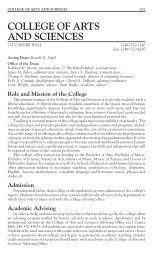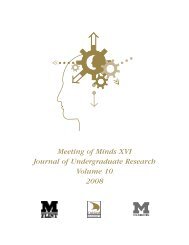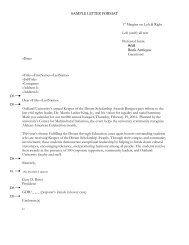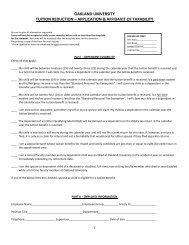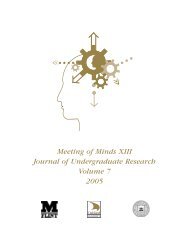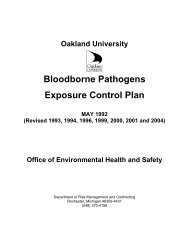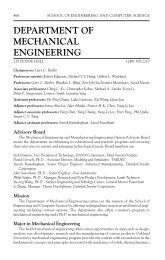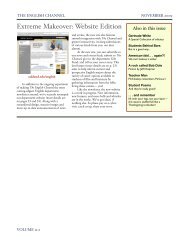MOM 2006 journal for pdf.pmd - University of Michigan-Flint
MOM 2006 journal for pdf.pmd - University of Michigan-Flint
MOM 2006 journal for pdf.pmd - University of Michigan-Flint
You also want an ePaper? Increase the reach of your titles
YUMPU automatically turns print PDFs into web optimized ePapers that Google loves.
IU/mL retinoids is the best concentration; higher or lower concentrations resulted in high<br />
mortality rates, and low tail regeneration, respectively. Furthermore, Maden reported that limb<br />
induction would <strong>for</strong>m during stages <strong>of</strong> hind-limb development (stages V-VI). Be<strong>for</strong>e or after this<br />
range <strong>of</strong> stages, no limbs to low frequency <strong>of</strong> limbs were induced. We found that within the<br />
range <strong>of</strong> stages IV-VI, there were no major differences in development. Finally, Maden also<br />
stated that proximal to midpoint level <strong>of</strong> amputation gave the best results, which is also what we<br />
have observed. When amputated at the proximal end, only one animal survived. In addition, reamputation<br />
at the same midpoint did not show us any significant differences. There were no<br />
unique abnormalities compared to analogous experimental animals.<br />
Maden (1993) found that even if tails were not induced to <strong>for</strong>m limbs, they would be inhibited<br />
to regenerate. In contrast, all tails in our research regenerated whether normally or abnormally.<br />
Additionally, Maden found that although limbs that were induced in the place <strong>of</strong> amputation were<br />
normal, the legs <strong>of</strong> tadpoles were abnormal [Maden, 1996]. We have shown that most tadpoles<br />
appeared to have normal <strong>for</strong>mation <strong>of</strong> legs, but some were indeed abnormal. One <strong>for</strong>med two<br />
legs on one side, <strong>for</strong> example [Fig. 1, C].<br />
Adding thyroxine illustrated somewhat faster regeneration, although results were limited since<br />
we only had only one thyroxine-experimental group. In addition, there were no unique<br />
abnormalities as a result <strong>of</strong> adding thyroxine.<br />
REFERENCES<br />
Lufkin, Thomas et al., 1992 Method <strong>for</strong> staining cartilage and bone together.<br />
Nature 359, 835-841.<br />
Maden, M. 1993 The homeotic trans<strong>for</strong>mation <strong>of</strong> tails into limbs in Rana temporaria by<br />
retinoids. Dev Biol 159, 379-391.<br />
Maden, M. 1998 Retinoids as endogenous components <strong>of</strong> the regenerating limb and tail.<br />
Wound Rep Reg 6, 358-365.<br />
Maden, M. and J. Corcoran 1996 Role <strong>of</strong> thyroid hormone and retinoid receptors in the homeotic<br />
trans<strong>for</strong>mation <strong>of</strong> tails into limbs in frogs. Dev Genet 19, 85-93.<br />
Maden, M. and M. Hind 2003 Retinoic acid, a regeneration-inducing molecule.<br />
Dev Dynamics 226, 237-244.<br />
Taylor, A.C. and J.J. Kollros 1946 Stages in the normal development <strong>of</strong> Rana pipiens larvae.<br />
Anat. Rec. 94, 7-23.<br />
Meeting <strong>of</strong> Minds <strong>2006</strong> 147



